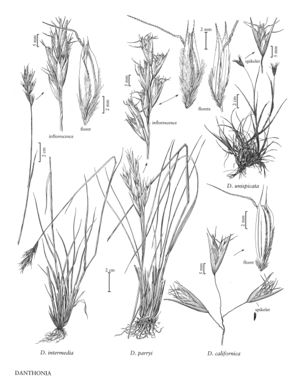Difference between revisions of "Danthonia parryi"
FNA>Volume Importer |
FNA>Volume Importer |
||
| Line 17: | Line 17: | ||
-->{{Treatment/Body | -->{{Treatment/Body | ||
|distribution=Alta.;Sask.;Colo.;N.Mex.;Wyo.;Mont. | |distribution=Alta.;Sask.;Colo.;N.Mex.;Wyo.;Mont. | ||
| − | |discussion=<p>Danthonia parryi is endemic to western North America and is often a major component of grasslands on the eastern foothills of the Rocky Mountains. It grows in open grassland, open woods, and rocky slopes, at elevations up to 4000 m. It rarely produces caryopses in the terminal inflorescences. This and its somewhat intermediate morphology have led to speculation that it is derived from hybridization between D. californica and D. intermedia.</p> | + | |discussion=<p><i>Danthonia parryi</i> is endemic to western North America and is often a major component of grasslands on the eastern foothills of the Rocky Mountains. It grows in open grassland, open woods, and rocky slopes, at elevations up to 4000 m. It rarely produces caryopses in the terminal inflorescences. This and its somewhat intermediate morphology have led to speculation that it is derived from hybridization between <i>D. californica</i> and <i>D. intermedia</i>.</p> |
|tables= | |tables= | ||
|references= | |references= | ||
| Line 26: | Line 26: | ||
-->{{#Taxon: | -->{{#Taxon: | ||
name=Danthonia parryi | name=Danthonia parryi | ||
| − | |||
|authority=Scribn. | |authority=Scribn. | ||
|rank=species | |rank=species | ||
| Line 33: | Line 32: | ||
|basionyms= | |basionyms= | ||
|family=Poaceae | |family=Poaceae | ||
| − | |illustrator=Linda A. Vorobik | + | |illustrator=Linda A. Vorobik;Hana Pazdírková |
| + | |illustration copyright=Utah State University | ||
|distribution=Alta.;Sask.;Colo.;N.Mex.;Wyo.;Mont. | |distribution=Alta.;Sask.;Colo.;N.Mex.;Wyo.;Mont. | ||
|reference=None | |reference=None | ||
| Line 39: | Line 39: | ||
|publication year= | |publication year= | ||
|special status= | |special status= | ||
| − | |source xml=https:// | + | |source xml=https://jpend@bitbucket.org/aafc-mbb/fna-data-curation.git/src/f50eec43f223ca0e34566be0b046453a0960e173/coarse_grained_fna_xml/V25/V25_966.xml |
|subfamily=Poaceae subfam. Danthonioideae | |subfamily=Poaceae subfam. Danthonioideae | ||
|tribe=Poaceae tribe Danthonieae | |tribe=Poaceae tribe Danthonieae | ||
Revision as of 21:39, 16 December 2019
Culms 30-80(100) cm, not disarticulating at maturity. Sheaths glabrous or sparsely pubescent; blades 15-25 cm long, to 4 mm wide, glabrous or scabrous (rarely pilose), uppermost cauline blades erect or diverging less than 20° from the culm at maturity. Inflorescences usually paniculate, sometimes racemose, with (3)4-11 spikelets; branches appressed to ascending, somewhat flexible; pedicels on the lowest branch from shorter than to as long as the spikelets. Spikelets 16-24 mm. Calluses of middle florets longer than wide, concave abaxially; lemma bodies 5.5-10 mm, backs usually pilose, especially near the base (rarely glabrous), margins pilose, teeth 2.5-8 mm, aristate; awns 12-15 mm; anthers to 6.5 mm. Caryopses rarely produced, 3.5-5.2 mm long, 0.9-1.8 mm wide. 2n = 36.
Distribution
Alta., Sask., Colo., N.Mex., Wyo., Mont.
Discussion
Danthonia parryi is endemic to western North America and is often a major component of grasslands on the eastern foothills of the Rocky Mountains. It grows in open grassland, open woods, and rocky slopes, at elevations up to 4000 m. It rarely produces caryopses in the terminal inflorescences. This and its somewhat intermediate morphology have led to speculation that it is derived from hybridization between D. californica and D. intermedia.
Selected References
None.
